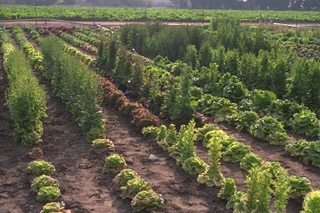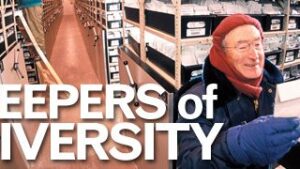The NPGS is the largest distributor of plant genetic resources in the world.
The USDA-ARS National Plant Germplasm System (NPGS) contains a wealth of genetic diversity including improved varieties, breeding lines, landraces and crop wild relatives (CWR). Its hundreds of thousands of plant germplasm accessions have the potential to be a gold mine of genetic diversity for new, adapted varieties for food and fiber to feed the world’s growing population.
“The NPGS is the largest distributor of plant genetic resources in the world,” says Patrick Byrne, Colorado State University professor of plant breeding and genetics.
“Until breeders access the NPGS collection and use its genetic resources, the system is nothing more than a fancy morgue filled with dying potential for improved crops adapted to a changing climate.”
Germplasm from the NPGS is freely available upon request without restrictions for breeder use anywhere globally for plant breeding (assuming required import permits are provided). A Standard Material Transfer Agreement of the
International Treaty on Plant Genetic Resources for Food and Agriculture, which specifies certain conditions of use, accompanies accessions distributed outside the U.S. Germplasm is distributed as seeds, cuttings, dormant budwood, DNA, leaves, fruit, pollen, tubers, bulbs and in vitro cultures.
Although about 250,000 accessions are distributed worldwide annually, a number of constraints limit the use of the system by plant breeders.
Constraints on Increased Use
Lack of accession information
Often, little data about the original sampling site is available for individual accessions. Phenotypic data are typically either of uneven quality or absent.
The data that are available are often not relevant to breeding target traits, and have been recorded using many different descriptors.
“Data on quantitative traits is especially lacking,” Byrne says. “Many or most requesters of germplasm do not report back any evaluation data.”
Technical constraints
There may be limited fertility in interspecies crosses due to differences in ploidy level or other reproductive barriers. Recombination between chromosomes of wild and domesticated species is sometimes suppressed
“Useful alleles may be hidden within an otherwise non-adapted background, leading to delayed maturity, disease susceptibility or unacceptable fruit or seed characteristics,” says Gayle Volk, research plant physiologist, USDA-ARS Plant Germplasm Preservation Research, Fort Collins, Colorado.
Making NPGS More Relevant
Optimizing Collections
Acquisition priorities for new germplasm must be balanced with multiple resource demands and maintenance and/or regeneration needs. Filling gaps may be constrained by political, logistical and economical factors.
“Crop wild relatives are felt to be underrepresented for many crops, but bring special challenges,” says Byrne. “Stakeholder input, including from Crop Germplasm Committees, help guide acquisition priorities.”
USDA sponsors several international explorations and exchanges every year.
Phenotypic evaluation
Arguably the most important challenge now in terms of time, cost, and complexity is to phenotype the collections. Continued development and implementation of phenotyping technologies is at the center of enabling large-scale phenotypic evaluation according to Byrne.
Although some USDA funded projects have included largescale phenotypic evaluation of NPGS collections, wheat, barley and carrot collections, for example, a more comprehensive effort is needed, say Byrne and Volk.
Targeted sequencing of accessions
Many of the world’s most important crop species have or are projected to have a draft reference genome sequence in the near future. This data can be used to design very low-cost PCRbased genotyping assays: AmpSeq and rAmpSeq.
“Targeted sequencing can be useful for germplasm management to eliminate redundancies and focus acquisition priorities,” explains Volk. “Genotype-phenotype analysis is also useful.”
Enhancing the GRIN-Global System
The usefulness of the USDA Germplasm Resources Information Network (GRIN) global system could be enhanced with better eco-geographic data on collection sites and more harmonized phenotypic evaluation data.
“Most plant breeders are reluctant to use germplasm that lacks site-specific collection data,” says Byrne. “Without a good phenotypic description, breeders are generally unwilling to risk their resources on unknown germplasm.”
Genome Editing
If geneticists can create precise variation anywhere in the genome, will germplasm collections become obsolete? Byrne and Volk do no think so.
“Genome editing relies on detailed information on phenotype- genotype associations,” Byrne says. “Because the phenotypes of importance in the future cannot be known in advance access to seeds or other propagules to allow evaluation of whole plants in appropriate agricultural settings will be required into the foreseeable future.”
Improved Germplasm Management Training
Up to one-third of curator and scientist staff of NPGS are expected to retire by 2020. How will new staff be trained? A conference to develop a training strategy for genebank managers has been organized by Byrne and Volk for April 2018 in Fort Collins, Colorado.
Breeders may also benefit from training on best practices for incorporating unadapted material into breeding populations.
Shared Responsibility
The activities listed here are beyond the scope of what any one institution can do on its own. They will be implemented most effectively through coordinated efforts among stakeholders, including USDA-ARS, USDA National Institute of Food and Agriculture (NIFA), universities, the private sector and international partners.
“We all have responsibility to raise awareness among public audiences about the current and potential value of NPGS collections,” Byrne concludes. “The world’s need is for active genetic gold mines, not merely germplasm repositories.”












